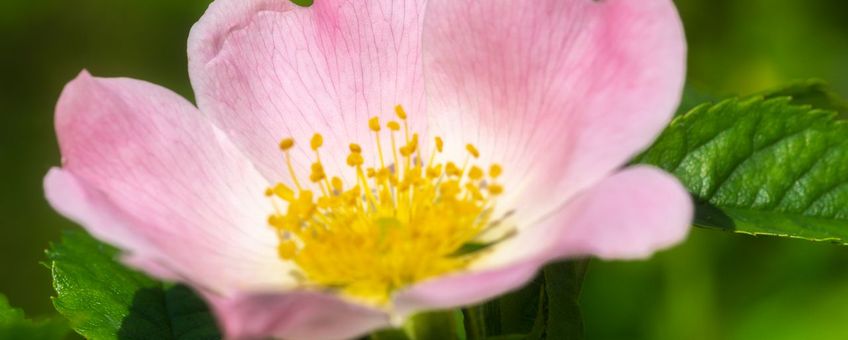
Plants & humans: dog rose
Hortus botanicus Leiden
A keystone in the wild
Every June, the dog rose opens its simple, white to pale pink flowers to a buzzing crowd of wild bees, beetles, and hoverflies. Leafcutter bees use the petals and leafs to line their nests, as the high tannin content helps keep mould and bacteria at bay. Young shoots sometimes sprout curious moss-like galls, homes to the gall wasp Diplolepis rosae, which in turn shelter parasitic wasps and other tiny residents.
By autumn, the scarlet rosehips shine in the hedges. Birds like fieldfares, redwings, and blackbirds feast on them, as do hedgehogs, mice, and foxes, especially in lean winter months.
A plant with global traditions
We humans also value this plant. In many cultures, the dog rose has long been part of everyday life. In Turkey and Georgia, rosehips are simmered into syrups and teas for both refreshment and traditional remedies for the heart and digestion. In Iran, extracts are used against kidney stones and high blood pressure. In Tunesia, distilled rosewater flavours sweets, drinks, and is used in rituals. In Kashmir, rosehips and petals become gulkand, a fragrant rose paste prized for its cooling, restorative qualities.
Europe’s rose of health
The Romans steeped rosehips in spiced wines and medicinal pastes. In the Middle Ages, rosehip tea was an important remedy for colds and fever, often prepared in monastery gardens where the plant was grown as both an ornamental and a useful crop. In Scandinavia, nyponsoppa, a sweet rosehip soup served with cream or almond biscuits, remains a winter favourite. In Austria and Germany, rose hips are made into jam (Hagebuttenmarmelade), which is traditionally eaten with bread and pastries. In folk medicine in many European countries, the dog rose symbolized protection and health, especially because its fruit is rich in vitamin C. Its flowers and hips were not only processed into food, but also used in scented sachets.

The name Rosa canina may recall an old belief that its root cured rabies, which is unfortunately not true. In Hildesheim, Germany, legend has it that the oldest dog rose has been climbing the cathedral wall since the ninth century and is even said to have survived the bombings of the Second World War.
Wartime lifeline
During World War II, the plant emerged as a lifesaver. In Great Britain, as well as in parts of North America and what was then British India, rosehip syrup was mass-produced to prevent scurvy, as citrus fruits were unavailable due to blockades. In the Netherlands, children gathered rosehips by the basketful, participating in a national effort to turn them into precious winter vitamins.
From hedgerow to skincare jar
Today, the dog rose is often found in cosmetics and food supplements. Oil pressed from the seeds of its fruit is rich in antioxidants, essential fatty acids, and natural vitamin A, hydrating skin and helping with collagen production.
More than thorns and petals
The dog rose is a bridge between seasons, species, and cultures. In spring, its blossoms feed pollinators. In winter, its rosehips sustain wildlife and people alike. Season after season, it knots nature’s threads into a living tapestry where nature and ethnobotany exist side by side.
Text: Marie Förg, Hortus botanicus Leiden
Images: Cunie Sleijpen; Otto Wilhelm Thomé, Flora von Deutschland Österreich und der Schweiz, 1885; Marie Förg


